To contact us Click
HERE
 |
| View of Columbia River east of Portland Oregon |
If your plans for a
western trip call for a visit to the
American Northwest, Oregon is a must destination. The state of
Oregon and historic
Oregon City, just a few miles south of Portland, tell much of the story of westward immigration during the middle part of the 1800's. The history found there and the unsurpassed beautiful scenery make Oregon an excellent vacation destination. Between the beautiful
Columbia River Gorge just east of Portland, to the fertile
Willamette Valley,
Willamette River, Mount Hood and the
mountainous coastline, Oregon can either be a part of you vacation or the entire thing.
The first United States citizens to arrive
overland in present day Oregon were among the
Lewis and Clark Expedition of 1804-1805. This was followed in 1810 by the
Astor Expedition which sought to establish a fur trading operation in the area. Fort Astoria was established at the mouth of the Columbia River at the site of today's
Astoria Oregon.
A 2,000 Mile RouteThe city of
Oregon City itself is both historic and scenic. Located along the
Willamette River, Oregon City was the final destination for most of the
Oregon Trail immigrants. If you're looking for the e
nd of the Oregon Trail, it can be found at Oregon City, Oregon.
 |
| Willamette Falls |
The Oregon Trail was composed of a series of very old Indian trails and in some cases animal trails. These trails or paths were first used by white fur trappers and traders. The trail ran west from Independence Missouri through Nebraska and Wyoming. In western Wyoming near
Fort Bridger, the trail parted. Those seeking to reach Oregon traveled northwestward along the
Snake River and then down the
Columbia River and finally up the Willamette River. Those heading to California would take a southwestward route over Utah and Nevada and eventually Donner Pass in the Sierra Nevada. Some travel was by river and at times around the many mountains and hills in the region. It was a treacherous
2,000 mile journey. The dangers present were not only from hostile Indians and possible starvation but also from sickness, in most cases cholera and smallpox. After a steady rise, immigration to Oregon peaked in 1852.
The Founding of Oregon City The entire area of present day Oregon and Washington state was at one time inhabited by workers for the
Hudson's Bay Company. This was long before the Oregon Trail days. Their main base of operation was at
Fort Vancouver, just across the Columbia River from present day Portland Oregon. In 1829, the Chief Factor at Fort Vancouver,
Dr. John McLoughlin, planned a two square mile settlement at
Willamette Falls on the Willamette River. He had three houses built which were burned down in short order by local Indians. McLoughlin was not deterred and had the houses rebuilt. From there the settlement grew with a mill being constructed using the Willamette Falls as a power source. These were the first buildings of a white settlement in Oregon. Most of the inhabitants were workers for the Hudson's Bay Company. At the time, the settlement was called Willamette Falls.
 |
| McLaughlin House |
Willamette Mission
In 1834,
the Reverend Jason Lee and his nephew, Reverend Daniel Lee, were approved by the
Mission Society of the Methodist Episcopal Church to establish a mission in the west. When the Lees arrived at Fort Vancouver, Dr. McLoughlin encouraged them to start their work south of the Columbia River in the Willamette Valley. The
Willamette Mission was established in 1834 in present-day Marion County.
A key event occurred in
1839 when Reverend Jason Lee traveled to Illinois for a series of lectures. Reverend Lee was looking for recruits for the Willamette Mission as well as settlers to Oregon in general. His travels were met with success. The country was going through a financial depression at the time therefore there were many looking for a fresh start. This was the beginning of the Oregon Trail days.
The First SettlersHeeding the call of Reverend Lee, the first settlers arrived in the
Willamette Valley in late 1839 and early 1840.
Each year thereafter, immigration to Oregon increased. Oregon City was the destination of most. From there they could obtain parcels of land and begin their homesteads. The early settlers in the 1840's called the falls,"Hyas Tyee Tumwater" which is generally translated into "Great Chief Falls". This was the name given by the
Clackamas Native Indians of the area. Today there is a dam and locks at the falls including a fish ladder. The Indians eventually relocated to
Grande Ronde Reservation by the 1850's with a few groups remaining in Clackamas County. It's estimated that about 53,000 settlers arrived in Oregon between 1841 and 1860.
 |
| Oregon City Municipal Elevator |
Creation of America's Northwest Ever since the end of the 1700's, the Pacific Northwest was a contested area between Great Britain and the United States. Great Britain's presence in the area was largely through the Hudson's Bay Company. In 1846, the United States and
Great Britain finally divided the land of the Northwest. The U.S. obtained what is today Oregon, Washington, Idaho and parts of Montana and Wyoming. Territorial status for Oregon would not happen until 1848 and not until a tragedy sped up the process. In November of 1847, the
Whitman Mission near Walla Walla Washington was attacked by Indians. Both Mr. and Mrs.Whitman and several others were killed. Some 50 plus including women and children were kidnapped. This tragedy so shocked the U.S. Congress that the region was divided into Territories and
Oregon received territorial status in 1848.
 |
| Oregon City from atop the bluff |
Things To Do In Oregon City The Willamette Falls- The Willamette Falls is the largest waterfall in the Pacific Northwest and only second to Niagara Falls in volume.
The Oregon State Welcome Center and Official End of the Oregon Trail- 1726 Washington Street.
McLaughlin House- 713 Center Street.
Two additional Western Trips articles and photos you'll enjoy are a trip on the Amtrak Coast Starlight and the Oregon Trail wagon ruts at Lake Guernsey State Park in Wyoming.
The Museum of the Oregon Territory- 211 Tumwater Drive.
The Oregon City Municipal Elevator- A very unique must stop on any visit to Oregon City.Most of the town during the early years was located along the river. When the city grew, there was a need to find an easier way to get up the ridge line to the east. In 1867, steps were built to help one get up the bluff. An elevator made of steel and wood was put into operation in 1915 powered by water pressure. In 1924, the power source was changed to electricity. The existing elevator was built in 1955. This is one of just four municipal elevators in the world. After ascending the bluff you'll have a terrific view of Oregon City, the Willamette River and the Willamette Falls.
This is a spectacular part of Oregon and filled with history.
(Photos from author's private collection)





 "THERE'S A PLACE CALLED OMAHA NEBRASKA," Groucho Marx sang once, before misplacing the town on the map: "In the foothills of Tennessee." Singers don't seem to know just where Omaha is, come to think of it. All the Counting Crows knew was that the town was "somewhere in Middle America," while Bob Seeger placed himself "on a long and lonely highway, east of Omaha," which could be just about anywhere that's not west of Omaha. Way to be specific, gents.
"THERE'S A PLACE CALLED OMAHA NEBRASKA," Groucho Marx sang once, before misplacing the town on the map: "In the foothills of Tennessee." Singers don't seem to know just where Omaha is, come to think of it. All the Counting Crows knew was that the town was "somewhere in Middle America," while Bob Seeger placed himself "on a long and lonely highway, east of Omaha," which could be just about anywhere that's not west of Omaha. Way to be specific, gents. We begin, as we always do, on Saddle Creek at the Homey Inn. This small neighborhood bar has gotten quite busy recently, since Esquire named it one of the best bars in America; it used to be quite desolate, except on weekends, when all Omaha bars spring to life.
We begin, as we always do, on Saddle Creek at the Homey Inn. This small neighborhood bar has gotten quite busy recently, since Esquire named it one of the best bars in America; it used to be quite desolate, except on weekends, when all Omaha bars spring to life.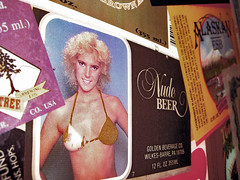 They also have champagne on tap, both sweet and dry. Of course, it's not real champagne, but rather a fruity and inexpensive sparkling wine, but who cares, really? They don't know how to make a champagne cocktail with the stuff, but they will gamely try, tossing in a few drops of bitters and a packet of sugar. You wouldn't serve it to Humphrey Bogart, but it's passable.
They also have champagne on tap, both sweet and dry. Of course, it's not real champagne, but rather a fruity and inexpensive sparkling wine, but who cares, really? They don't know how to make a champagne cocktail with the stuff, but they will gamely try, tossing in a few drops of bitters and a packet of sugar. You wouldn't serve it to Humphrey Bogart, but it's passable.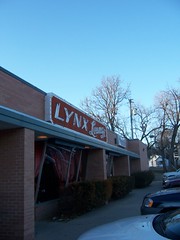 Next, it's onward to The Lynx Lounge, just a few blocks away on NW Radial Hwy. The bar is rather unassuming to look at from the outside, nestled in a strip mall between an assortment of low-rent businesses that have, in the past, included an off-brand makeup store and an erotic lingerie dealer. Inside, however, the bar is pure Seventies, including a fire pit and a recessed and mirrored alcove where couples can pair off for a more intimate drinking experience. The bar is kept dark, and the alcove may be the darkest spot on earth -- it is pitch black until a bartender lights a candle, and then the only thing visible in the alcove is the candle.
Next, it's onward to The Lynx Lounge, just a few blocks away on NW Radial Hwy. The bar is rather unassuming to look at from the outside, nestled in a strip mall between an assortment of low-rent businesses that have, in the past, included an off-brand makeup store and an erotic lingerie dealer. Inside, however, the bar is pure Seventies, including a fire pit and a recessed and mirrored alcove where couples can pair off for a more intimate drinking experience. The bar is kept dark, and the alcove may be the darkest spot on earth -- it is pitch black until a bartender lights a candle, and then the only thing visible in the alcove is the candle.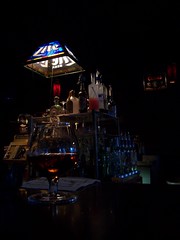 Anyway, we've been patronizing the Lynx Lounge for years, for their good selection of brandies, their swanky ambiance, and their terrific jukebox upon which you can find a marvelous selection of soul and R&B songs. We may be too light-skinned to pretend to be Billy Dee Williams, but that doesn't mean we won't drink at a place where he would seem perfectly at home. (SPARBER)
Anyway, we've been patronizing the Lynx Lounge for years, for their good selection of brandies, their swanky ambiance, and their terrific jukebox upon which you can find a marvelous selection of soul and R&B songs. We may be too light-skinned to pretend to be Billy Dee Williams, but that doesn't mean we won't drink at a place where he would seem perfectly at home. (SPARBER) AS YOU MIGHT EXPECT from a city that retains so much of the architecture of the 50s and 60s, Omaha has a tiki bar, a remainder of America's obsession with Polynesian culture. One day we at the Bottle Gang will tackle the enormous legacy of tiki culture, but it is a vast topic, and we shall limit our comments here to one point: There was almost nothing Polynesian about the way Americans expressed their interest in Polynesia. The word "tiki" is Maori. The tropical drinks served in tiki bars were generally inspired by drinks from the Caribbean. The style of music most associated with tiki culture, such as the lush exotica of Les Baxter, borrowed heavily from South American music. And tiki bars were often nestled in the back or the basement of Chinese or Japanese restaurants -- if you are looking for a well-made tropical drink nowadays, there is still a very good chance of finding one at a Chinese restaurant.
AS YOU MIGHT EXPECT from a city that retains so much of the architecture of the 50s and 60s, Omaha has a tiki bar, a remainder of America's obsession with Polynesian culture. One day we at the Bottle Gang will tackle the enormous legacy of tiki culture, but it is a vast topic, and we shall limit our comments here to one point: There was almost nothing Polynesian about the way Americans expressed their interest in Polynesia. The word "tiki" is Maori. The tropical drinks served in tiki bars were generally inspired by drinks from the Caribbean. The style of music most associated with tiki culture, such as the lush exotica of Les Baxter, borrowed heavily from South American music. And tiki bars were often nestled in the back or the basement of Chinese or Japanese restaurants -- if you are looking for a well-made tropical drink nowadays, there is still a very good chance of finding one at a Chinese restaurant.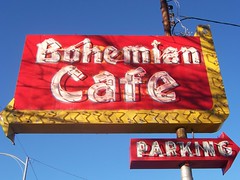 Across town, on 13th Street just south of downtown, is another ethnic restaurant, one that has always been indisputably authentic. The Bohemian Cafe was started by a Czech family all the way back in 1924, and still features employees dressed in traditional Czech outfits. Their menu consists of Eastern European dishes such as jaeger schnitzel, or veal steaks in wine sauce and mushrooms, and the food tends to be meaty and heavy: We once ordered plum dumplings that came in a bowl filled with butter and cream, and took close to three weeks to eat.
Across town, on 13th Street just south of downtown, is another ethnic restaurant, one that has always been indisputably authentic. The Bohemian Cafe was started by a Czech family all the way back in 1924, and still features employees dressed in traditional Czech outfits. Their menu consists of Eastern European dishes such as jaeger schnitzel, or veal steaks in wine sauce and mushrooms, and the food tends to be meaty and heavy: We once ordered plum dumplings that came in a bowl filled with butter and cream, and took close to three weeks to eat. 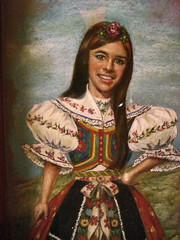 As to the drink that this young boor mocked, well, it was actually rather good. It is a sidecar, of sorts, but made with slivovitz, which is a Balkan plum brandy. It's a scorcher of a liquor, as anyone who has tried it can tell you. It's the sort of drink that grows hair on your chest, and then sets fire to those hairs. But the harshness of the brandy is undercut in this drink by Limoncello, Triple Sec, and lemon juice, and the resulting drink is actually quite satisfying. Fools may laugh at us for ordering it, and laugh harder that we like it. But fools will be fools, and, at the end of the day, as happened on this occasion, will have a second bartender, the mother of the first, threaten them with a baseball bat. (SPARBER)
As to the drink that this young boor mocked, well, it was actually rather good. It is a sidecar, of sorts, but made with slivovitz, which is a Balkan plum brandy. It's a scorcher of a liquor, as anyone who has tried it can tell you. It's the sort of drink that grows hair on your chest, and then sets fire to those hairs. But the harshness of the brandy is undercut in this drink by Limoncello, Triple Sec, and lemon juice, and the resulting drink is actually quite satisfying. Fools may laugh at us for ordering it, and laugh harder that we like it. But fools will be fools, and, at the end of the day, as happened on this occasion, will have a second bartender, the mother of the first, threaten them with a baseball bat. (SPARBER)
























